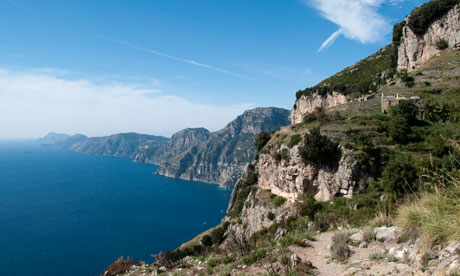
Domenico was sitting silently by the deserted monastery, sheltering from the sun under a fig tree, and our sudden appearance took him by surprise. Jumping to his feet, he took one look at us – a pair of bedraggled walkers – and gestured towards the moth-eaten armchairs in the courtyard.
He spends his days looking after ramblers that pass by the 16th-century San Domenico convent, which clings to a mountainside overlooking the Amalfi coast, and rushed away to fetch a bowl of figs and cups of freshly squeezed lemon juice.
We enjoyed this heavenly reward on the Path of the Gods, named for the Roman temples that once stood here. It's a 10km section – between Praiano and famous Positano – of one of Italy's most picturesque hiking routes, along the Amalfi coast. For more than an hour we had climbed steps that zig-zagged up the mountain. Lizards lazed on rocks and butterflies fluttered among the trees.
The views became more dramatic with every step: the sea fizzing over the craggy coast and, further ahead, Positano's landslide of matchbox houses tumbling down the cliffs. Far below, Praiano's traffic hummed.
Most people choose to drive the Amalfi coast, swerving around the 1,000 hairpin bends in small Fiats or on rattling Vespas, but walking the 40km coastline takes you beyond the celebrated spots and, with cooler temperatures and fewer crowds, autumn is the time to do it.
Our self-guided hike along the coast's ancient pathways would take us from the town of Amalfi to Sorrento, walking around five hours (9-13km) a day, via lesser-known villages hidden deep in the valleys and forested peaks.
Before setting off, I spent a day exploring the area around Amalfi. Tiny Scala, built by shipwrecked Romans en route to Constantinople, is the oldest settlement on the coast, dating from the fourth century, and we wandered its empty streets, forgoing sanguinaccio – a pudding made from chocolate and pig's blood – in favour of a scoop of nocciola (hazelnut) gelato from the only cafe, on the small cobbled square.
After a night in Amalfi, visiting limoncello shops and sleeping at the Hotel Lidomare, an early 14th-century building full of antiques – we made for the old fishing village of Praiano. The trail passed small shrines adorned with flowers and was mostly deserted until we emerged at a roadside to find shacks selling small, fiery chillis and a truck piled high with melons.
Praiano was quiet (as usual, said the receptionist at the Tramonto d'Oro hotel), but appealing, with pretty bays, colourful local characters and a great restaurant, La Strada (lastradaristorante.it), carved into the rock face with heart-stopping sea views from its terrace. On the menu was sea bass cooked in "Crazy Water" – a broth of garlic, parsley and tomatoes originally used by sailors who cooked using seawater when Amalfi was a maritime republic in the 1100s.
We spent a few hours at Praia, on a tiny pebbled beach where swimmers dived from the pontoon into the sapphire water, and chatted to Paolo Sandulli, an artist who had turned an old cylindrical stone defence tower – built in the Middle Ages to ward off the Saracens – into a studio. Then it was a sweaty ascent to the San Domenico convent (580m), a vertiginous route beside sheer rocky drops.
For all the glitz and glamour, luxury boutiques, big yachts and helipad, Positano, when we arrived three hours later, was all style and no substance. But a short way up the mountain was Montepertuso, little more than a church and cluster of whitewashed homes, where we discovered the area's real heart and soul. It had one greengrocer and only five places to eat, including the fantastic Il Ritrovo (ilritrovo.com). Draped over the dining room's wooden beams were hundreds of vine tomatoes, hanging in grape-like bunches for preservation ahead of winter. Owner and head chef Salvatore Barba told us, modestly: "All my food is spectacular!" – and he was right. The bruschetta, the panna cotta, the pasta with porcini, sausage and creamy smoked cheese were all extraordinary. I left Il Ritrovo feeling crestfallen.
"Why?" asked a worried Salvatore.
"I fear I may never again eat anything quite so perfect," I replied.
Salvatore laughed. "You know, Montepertuso is a special place. This is where locals from Positano come. Now it's easy but before the road was built 20 years ago, the only way up here was to take the steps – all 1,700 of them. We all had very good legs …
"Positano is beautiful but, up here, this is the true spirit of Amalfi."
• Nick's trip was provided by On Foot Holidays (01722 322652, onfootholidays.co.uk). A seven-night self-guided walking trip along the Amalfi coast costs from £690, including B&B accommodation and one night in a family-run 18th-century agriturismo. EasyJet (0843 104 5000, easyjet.com) flies to Naples from Stansted, Bristol, Edinburgh and Liverpool from £53 return. More information at italia.it

